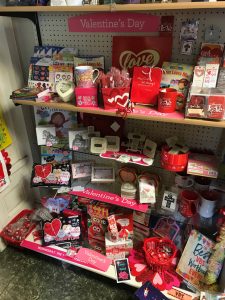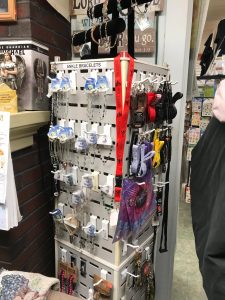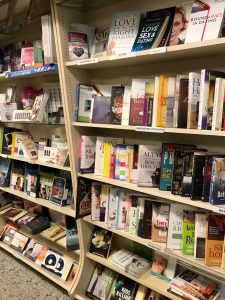Upon initially entering Bible Depot, it is difficult to find any particular motive of organization for the merchandise inside. While the books and gifts in the store are neatly organized into labeled sections, what I found difficult was understanding the juxtaposition of certain sections in relationship to one another. The more I thought about it, though, the organization of the sections gradually became clearer to me.
According to an earlier interview with Nancy Ney, the store’s current owner, Bible Depot is a store that caters to anyone who believes in “the one God,” the practicing monotheist. That being said, the store is of particular interest to this practicing monotheist looking to strengthen or renew his relationship with God. This orientation is made very clear the minute a customer steps into the store. 
The entrance of the store is a little strangely situated. Rather than having a traditional front entrance, the store’s only entrance is on the side of the building. After passing through the door, there isn’t really any sort of lobby or main entryway either. The first thing I saw when I opened the door was their seasonal merchandise section offering things relating to current holidays (depending on the day I was there I saw Valentine’s Day, St. Patrick’s Day, and now Easter merchandise). Since you can’t really walk forward when you enter the store, you can either turn left toward the front counter, or turn right toward the books. I, of course, turned right.
This room, the biggest room in the store is the one filled with the most books. While the merchandise is shelved in a very organized manner, some of the organization in this big rectangular room just didn’t seem to make sense to me. How does this stock relate to the stock in the other large room on the opposite side of the store? How does the location of all the rooms relate to one another and how does the placement of the front room with the checkout counter relate to these other rooms?
What I’ve found is that even though the store seems unorganized at first, upon closer inspection, maybe that’s the point. It’s sometimes easy to forget that while this is Nancy Ney’s store, it is also her actual home. Walter Benjamin tells us in his anecdote “Unpacking My Library” that “ownership is the most intimate relationship that one can have to objects. Not that they come alive in him; it is he who lives in them” (67). Or perhaps it is she who lives in them, or rather lives within them, as Nancy quite literally lives surrounded by the objects in her store. Because of this duality of purpose of this space, the organization of the store seems almost to reflect that of someone’s home library.
Returning to the large book room, moving to the right from the entrance it seems that this portion of the room is dedicated to strengthening one’s relationship with God through prayer with the hope of securing a place in heaven and a peaceful afterlife. Moving further, you reach the reference section where you can really dig into studying the Bible and various commentaries and dictionaries related to it. This section seems to progress nicely from the previous one because it gives foundational knowledge and practical learning for the already motivated monotheist looking to strengthen or renew their relationship with God through prayer. 
Finally, the last portion of the room, with all its books about relationships, self-help, counseling, seems to be the real-life application of what you’ve learned from the reference section. So as someone moves through this room, they start as one motivated to seek God through prayer, to someone who learns more about the history and texts of the religion, to someone who can then use that knowledge and motivation to practically apply these skills and this faith to their everyday lives, whether that is to a particular hardship they are facing, or if they are just looking for a general guide to a better life.

If you move through the small hallway to the greeting card and celebration room, this can also be seen as a practical application of knowledge from the reference section to the various sacraments and celebrations within the religion. Looking at the room on the other side of the store, it seems like more of a grab-and-go room. Because this room is filled with resources more than books, customers would probably need to have a good idea of what they’re looking for so that they can just come in, find it, and purchase it without needing to take time to leisurely explore the other items in the room. That being said, if they see something that catches their eye (of which there are plenty of things), they might stop and take a look.
The final, and arguably the most important room, giving the store its namesake, is the “Bible Room.” This room is given a sanctity that the other rooms do not have because it is tucked away, nestled in a spot away from everything else to give it a particular reverence. Even the way it is organized shows that there is a clear centerpiece to the room – the desk. This is also one of only two rooms that leads directly into Nancy’s home in the center of the building, which shows the significance of having it close to her at all times.
In Peter N. Miller’s article for The Chronicle Review about “How Objects Speak,” he quotes Rainer Maria Rilke’s desire to “awaken our astonishment at seeing things and practices as exquisite bearers of identity, not simply as tools or products; not as ‘outputs’ but as essences” (Miller). Furthermore, Miller notes that “The history of the human species through things is a history of the human as creator and self-creator; in our own way, as Rilke would have it, divine” (Miller). This is an interesting thing to think about in terms of Bible Depot. Bruno Latour tells us when we have little investment in something we’re are more likely to view things as mere objects, not multidimensional “things.” However, thinking of objects as things gives them multiple meanings. There’s often a debate about the commodification of something as sacred as a book. How could we possibly ascribe a monetary value to something like that? In Bible Depot, there is a monetary value assigned to things that truly are sacred. How do we get away with that? I think the answer lies in both Miller’s quotation of Rilke and in Latour. Nancy Ney views these objects as things and has so much meaning and attachment to every item in that store and encourages that same kind of connection with all her customers. The organization of the store suggests, as Rilke would have it, that these books be viewed not only as tools, but as essences, as things that can give fulfillment, enrichment, and meaning to our lives. Through this concept we can see that Nancy Ney has used her deep passion and faith as a Divine Creator of the things in her store to encourage service of herself and her customers to the one true Divine Creator.
Sources:
Text:
Benjamin, Walter, and Hannah Arendt. Illuminations. New York: Schocken Books, 1986.
Miller, Peter N. “How Objects Speak.” The Chronicle of Higher Education 11 August 2014.
Images:
Courtesy of Olivia Bodner

0 Comments